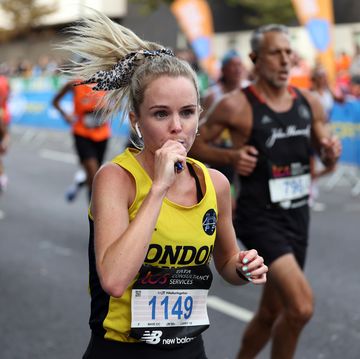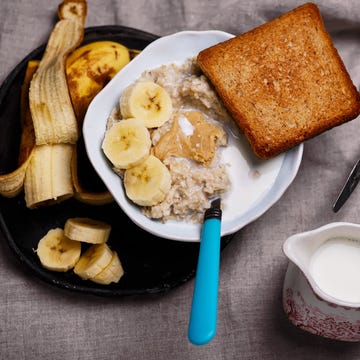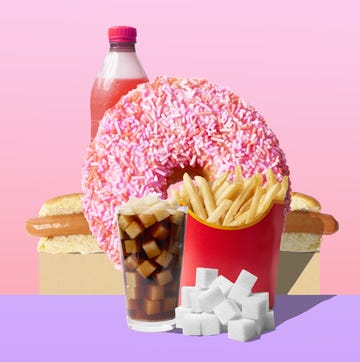At some point or another, we’ve all experienced the acute, uncomfortable pain that is muscle cramp. Whether it’s during a run or – arguably worse – when you’re trying to get some post-run rest in bed, cramp can come on instantly and unexpectedly and, although it is often harmless, can give the sensation that your ailing muscle is splitting in two.
But muscle cramps needn’t be inevitable, nor cramp your running style. We spoke with Melissa Mitri, registered dietitian at Welltech, to find out how reassessing your nutrition could hold the solution – and which surprising foods are the best at combatting cramp.
What is muscle cramp?
Muscle cramp is marked by involuntary, smarting spasms that can occur in any muscle, although it is most frequently experienced in the calf and foot. As noted by a study in the Journal of Strength and Conditioning Research, muscle cramp is a common complaint among most amateur and professional athletes alike – but ‘especially those involved in endurance sport or competition’ – and it usually comes on during or directly after exercise. Even though it can be ‘debilitating’, as the researchers rightfully describe, muscle cramp is often harmless and generally resolves itself after a relatively short period of time.
What everyone's reading
What causes muscle cramp?
As much as we’d love to point the blame at something, we can’t – several studies later and researchers are still yet to determine the exact cause of muscle cramp. However, factors like dehydration and electrolyte imbalances have been claimed to trigger muscle cramp, as well as muscle fatigue and tightness. With that in mind, if you tend to sweat a lot, or are running in hot weather, you’ll be sweating more than usual and losing more water and electrolytes in the process, which will increase your risk of experiencing muscle cramp.
‘For athletes, cramps aren’t usually a sign of poor conditioning, but rather the result of overworked muscles and dehydration,’ says Mitri. ‘For most people, cramps may occur if exercising longer or harder than usual. That’s why it’s important to gradually build endurance, stay hydrated and know how to prevent and ease muscle spasms.’
What can you do to prevent muscle cramp?
Less about the possible causes, now – and more about the practical solutions. How exactly do you stop muscle cramp from taking hold in the first place?
‘Stretching, maintaining a balanced diet and staying hydrated, especially for those who sweat a lot, are the most common recommendations to prevent muscle cramps,’ says Mitri. ‘But even when you do everything right, it can still be difficult to escape cramping – and that’s when foods with a high magnesium, potassium, or sodium content can be particularly helpful.’
Researchers have also found the consumption of acetic acid – which is often used as a preservative and flavour enhancer and found in things like vinegar, pickled foods and dressings – to be an effective way of preventing and relieving muscle cramp. Specifically, they concluded that ‘acetic acid ingestion [allows] athletes to potentially practice, compete or perform for extensive periods without experiencing a diminution in their physical capacity’ – and we’re all here for that kind of perk.
5 surprising foods to prevent muscle cramp
According to Mitri, if you are the active type, adding some ‘unexpected foods’ to your diet ‘might give you an extra edge’ when it comes to avoiding muscle cramps. Although she admits that you ‘might have to power through the texture and flavour’ of her top five options, here’s what they are – and why they work.
1. Pickle juice
The latest trends are getting us into a pickle. First, there’s the rise of pickleball – a whimsically-named, low-impact racket sport that has become a go-to social activity. Then, there’s the rise of pickle juice – a slightly obscure, high-acidity drink that has become a go-to tool for avoiding muscle cramp.
As eye-wincing as it sounds, Mitri says that drinking shots of pickle juice could serve you well, whether you’re preparing for a big game of pickleball or your weekend long run. ‘Pickle juice is one of the most well-known remedies for cramps and is backed by many athletes,’ says Mitri. ‘Muscle cramp is often caused by fatigue and the high sodium and acidity in pickle juice, which contains about 20 times more sodium and eight times more potassium than many sports drinks, can stimulate nerve receptors in the mouth and throat. These receptors then send signals to the affected muscle, helping it to relax and stopping the cramp almost immediately.’
How do you consume it?
Moderation is key when it comes to pickle juice – but that might be easy to achieve considering its acquired taste. ‘Pickle juice is typically more effective in small amounts, so try not to consume more than 85ml in a day,’ advises Mitri. ‘It is also important to note that while its high sodium content and acidity are effective in stopping muscle cramp, it can lead to problems for individuals with high blood pressure, kidney problems or gastrointestinal issues.’
2. Mustard
Another food with a divisive flavour profile that can help to prevent reduce muscle cramp is mustard. ‘A spoonful or small packet of yellow mustard is an old school cramp fix,’ says Mitri. ‘Similar to pickle juice, its high acetic acid content can help to replenish minerals like sodium and potassium.’
Mustard, notes Mitri, also contains turmeric, which is known for its anti-inflammatory qualities and can also reduce muscle pain and stiffness.
How do you consume it?
‘It’s recommended that you consume one or two teaspoons of yellow mustard at the first sign of cramping, either direct or mixed with a small amount of water,’ says Mitri. ‘The initial relief should start one or two minutes later. You can repeat this process if you feel that it’s necessary, but don’t consume more than four to six teaspoons of yellow mustard per day.’
3. Banana peel tea
If you’re a stalwart swigger of builder’s tea, you might need to widen your horizons. According to Mitri, opting for a more bizarre brew of banana peel could hold the secret to cramp-free exercise.
Bananas, she says, contain magnesium, potassium and calcium, which are three of the most effective nutrients for easing muscle cramp. However, not all runners like to consume solids on the move. ‘If you prefer to sip rather than eat while exercising, you might want to try banana peel tea,’ advises Mitri. ‘While boiling banana peels to make tea sounds unusual, it draws out the magnesium, potassium and calcium, which will reduce your chance of experiencing cramp.’
How do you consume it?
‘Start by thoroughly washing a ripe banana peel under running water, then cut it into smaller pieces,’ says Mitri. ‘Then, place the pieces of peel into a saucepan with water and bring it to the boil. After that, reduce the heat, let it simmer for 10-15 minutes, strain and enjoy! You can also leave it to rest and enjoy it as a chilled drink if you prefer.’
4. Tart cherry juice
Sweet and zingy, tart cherry juice might not be something that you regular add to your shopping basket – but it does hold plenty of benefits, from better sleep to improved recovery after exercise and, yes, greater relief from muscle cramp.
‘Tart cherry juice contains anthocyanin, which is an anti-inflammatory compound that can reduce muscle stiffness and pain,’ continues Mitri. ‘Some studies have also shown that tart cherry juice can even help with overall sports performance, as its low glycaemic index can cause a small increase in blood sugar levels.’
How do you consume it?
Mitri says that you should start taking tart cherry juice as soon as you start to feel symptoms of muscle cramp, no matter what the time of day. ‘It is important to note that tart cherry juice contains sugars, with some brands adding even more,’ she adds, as a caveat. ‘So, for anyone with diabetes or another condition that impacts blood sugar levels, I would recommend speaking to a doctor before consuming it.’
5. Hot sauce
If you want to avoid cramp, it’s time to dial up the heat. As Mitri notes, the chili peppers in hot sauce contain a chemical compound called capsaicin, which is not only responsible for giving the food its spicy, burning heat, but also a natural pain reliever.
‘When you consume spicy food, your neurons are busy focusing on the tingling sensation in your mouth, therefore won’t have any time to cramp up your muscles,’ says Mitri. ‘Additionally, capsaicin can also reduce inflammation, offering short-term relief from cramp pain.’
How do you consume it?
Add a smidgen of hot sauce – or however much you can handle – to any suitable dish to get your cramp-preventing capsaicin fix.


















